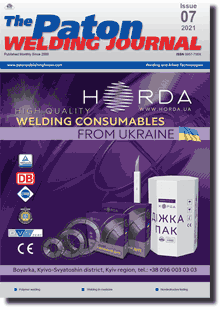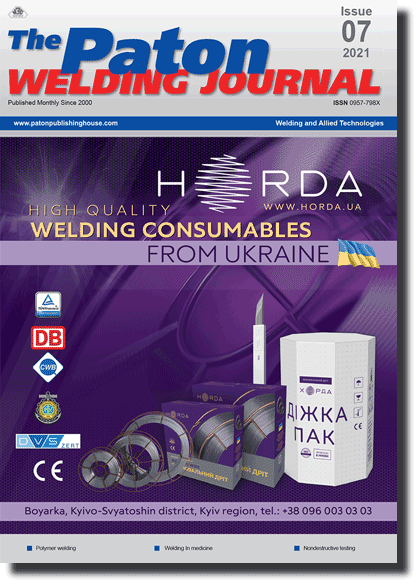| 2021 №07 (03) |
DOI of Article 10.37434/tpwj2021.07.04 |
2021 №07 (05) |

The Paton Welding Journal, 2021, #7, 19-23 pages
Heat-pulse welding of woven polymeric sheet materials
M.G. Korab, M.V. Iurzhenko, A.V. Vashchuk and A.M. Galchun
E.O. Paton Electric Welding Institute of the NASU. 11 Kazymyr Malevych Str., 03150, Kyiv, Ukraine. E-mail: office@paton.kiev.ua
Abstract
The aim of the work is to test the technology of welding filter bags made of polyester ultralight fabric of linen weaving. The tasks are the choice of welding method, creating an experimental installation, adjusting the parameters of the welding process and evaluating the quality of the produced welds. The method of heat-pulse welding with T-shaped welt seams with continuous penetration and simultaneous cutting of the welded material was chosen. An experimental installation with a heating element made of nichrome wire of 0.8 mm diameter was developed. During one cycle of heat-pulse welding, two longitudinal welds, the so-called T-shaped welt seams are formed, the shape and size of which depend on the heating mode of the polymeric material. Welded filter bags were turned before using in such a way that T-shaped seams in the working environment were directed inwards and the load on dangerous areas of welds was reduced. Mechanical tests of welds of filter polyester fabric produced by heat-pulse welding showed a sufficient level of their mechanical strength. To control the quality of the finished filter bags, it is sufficient to visually inspect the welds for leaks or other obvious defects. Results of the work is the technology of manufacturing filter bags from mesh polyester fabric by means of heat-pulse welding of welt seams with continuous penetration and cutting of the welded material is worked out. The welding installation was created. Parameters of a welding mode were established. It was determined that produced welded joints in terms of strength characteristics meet the necessary criteria for the intended use of filter bags made of ultra-thin polymeric fabrics. 9 Ref., 8 Figures.
Keywords: thermoplastics, welded joints, polyester fabric, heat-pulse welding
Received 21.02.2021
References
1. Arzhakov, M.S., Zhirnov, A.E., Efi mova, A.A. et al. (2012) Macromolecular compounds. Moscow, MGU [in Russian].2. Buketov, A., Brailo, M., Yakushchenko, S., Sapronova, A. (2018) Development of epoxy-polyester composite with improved thermophysical properties for restoration of details of sea and river transport. Advances in Materials Sci. and Engineering, 1-6. https://doi.org/10.1155/2018/6378782
3. Buketov, A., Brailo, M., Yakushchenko, S. et al. (2019) Investigation of tribological properties of two-component bidisperse epoxy-polyester composite materials for its use in the friction units of means of sea transport. Periodica Polytechnica Mechanical Engineering, 3(63), 171-182. https://doi.org/10.3311/PPme.13161
4. Polyester Manufacturing. [Accessed 10 May 2021].
5. Savostitskiy, N.A., Amirova, E.K. (2012) Materials science of clothing manufacture. Moscow, Akademiya [in Russian].
6. DSTU 2004. ISO 5498:1981. International Standards Offi ce. Agricultural food products. Determination of crude fi - bre content. General method.
7. Jevsnik, S., Vasiliadis, S., Bahadir, S. K. et al. (2016) Applying heat for joining textile materials. In Joining Technologies. Intech Open. https://doi.org/10.5772/64309
8. Midha, V.K., Dakuri, A. (2017) Spun bonding technology and fabric properties: А review J. Textile Eng. Fashion Techno., 1(4), 126-133. https://doi.org/10.15406/jteft.2017.01.00023
9. Filter polyester cloth of trade mark Saatifi l.
Suggested Citation
M.G. Korab, M.V. Iurzhenko, A.V. Vashchuk and A.M. Galchun (2021) Heat-pulse welding of woven polymeric sheet materials. The Paton Welding J., 07, 19-23.The cost of subscription/purchase order journals or individual articles
| Journal/Currency | Annual Set | 1 issue printed |
1 issue |
one article |
| TPWJ/USD | 384 $ | 32 $ | 26 $ | 13 $ |
| TPWJ/EUR | 348 € | 29 € | 24 € | 12 € |
| TPWJ/UAH | 7200 UAH | 600 UAH | 600 UAH | 280 UAH |
| AS/UAH | 1800 UAH | 300 UAH | 300 UAH | 150 UAH |
| AS/USD | 192 $ | 32 $ | 26 $ | 13 $ |
| AS/EUR | 180 € | 30 € | 25 € | 12 € |
| SEM/UAH | 1200 UAH | 300 UAH | 300 UAH | 150 UAH |
| SEM/USD | 128 $ | 32 $ | 26 $ | 13 $ |
| SEM/EUR | 120 € | 30 € | 25 € | 12 € |
| TDNK/UAH | 1200 UAH | 300 UAH | 300 UAH | 150 UAH |
| TDNK/USD | 128 $ | 32 $ | 26 $ | 13 $ |
| TDNK/EUR | 120 € | 30 € | 25 € | 15 € |
AS = «Automatic Welding» - 6 issues per year;
TPWJ = «PATON WELDING JOURNAL» - 12 issues per year;
SEM = «Electrometallurgy Today» - 4 issues per year;
TDNK = «Technical Diagnostics and Non-Destructive Testing» - 4 issues per year.


